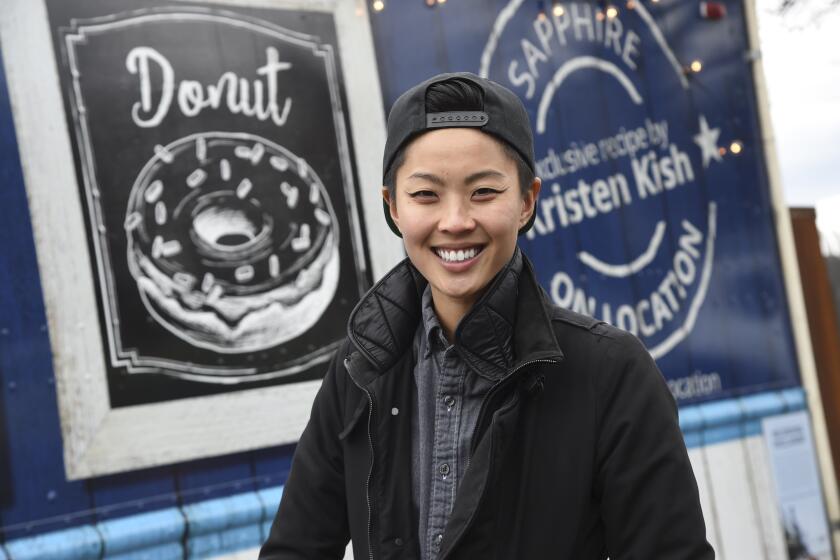Book Review : An Imitation of 18th-Century Life
- Share via
Through a Glass Darkly by Karleen Koen (Random House: $19.95)
“ ‘Through a Glass Darkly,’ ” writes Howard Kaminsky of Random House, “is that exciting and rare opportunity for a publisher--the chance to introduce a major new fiction writer with a stunning, big book.’ ”
The ads for Karleen Koen’s book trumpet, “Destined for bestsellerdom.” The publisher’s advance of $350,000--risky business for any house--has been recouped. Paperback rights brought $755,000. If the split was standard, that sale alone paid the advance. But the book has also been sold to the Book of the Month Club, and “for a record price.” Random House gambled and won, before a single amateur reader got his--or more probably, her--hands on the book.
Does “Through a Glass Darkly” have star quality? Yes. Yes, in spite of the inevitable surge of skepticism. Yes, even in spite of its faults. It’s something like a bodice-ripper crossed with a text of the French Annales school, which finds history secreted in everyday life. It’s an odd mix of the worldly, the quotidian and the naive, but somehow-- sometimes--it is satisfying.
Infused With History
The 18th Century has its devotees, Karleen Koen among them. “It was the age of Defoe, Pope, Swift and Addison,” she said, “and I lost myself in their time.” To write this book, she steeped herself in others, eventually listing nearly 300 in a formidable bibliography: a strong infusion of the period. Koen’s success is not beginner’s luck. It is beginner’s hard work.
This is the story of Barbara Alderly, “Bab,” 15 when we meet her, a country girl, abandoned with her siblings to the care of her grandmother, the redoubtable Alice, Duchess of Tamworth. Bab’s mother, Lady Diana, is in London, pursuing high life, evading creditors, seeking divorce. Bab’s father, the profligate Kit Alderly, has fled: He backed the wrong horse in the royal stakes and is now a traitor.
Yet the family’s standing is secure. Such is the renown of Barbara’s grandfather, the late first Duke of Tamworth, that his son-in-law’s politics hardly affect it. Debt, though, does menace the Alderly branch. When Lady Diana selects Barbara’s mate, her eye is on his money. Roger Montgeoffry has more than money: Handsome, adroit, he is a royal favorite. He long served as aide to the Duke of Tamworth and adored him. Barbara has always secretly loved the much older Roger. Will they live happily ever after? Let’s just say that the plot is as twisted as an Elizabethan chimney stack.
A hundred details of daily life in England and France are tucked in here. Oak paneling that time will darken is still the color of honey; law students dash in their nightclothes to the coffeehouses (the Grecian or Squire’s or Searle’s) near the Inns of Court; Roger sells his war horse with his commission.
Bab, to begin, is consistently well-drawn, a vivid, spirited character. It’s a treat to watch her grow and assume her place: “I am mistress of the household, you see. And I do not feel it has been established clearly.” Her very first try, age 16.
Things are not always so fluent. Tony, the likable second Duke of Tamworth, is tongue-tied in the most unlikely, exasperating way. The 20th Century creeps in: “I am glad we had this discussion,” says Diana to the Duchess. The mouths of astonished people keep forming O’s. There is repetition, hyperbole, a whole gang of funny mixed metaphors and the most staccato speech patterns since Marilyn French.
The first part of the book is leisurely; the second, rushed. Dark holes of events that might have been acted before us are presented instead as memories. There’s a runaway plot, and the whole construct wobbles like jelly. Still, the book tempts one on to the end--an end that could serve as a beginning. Will there be a sequel to this book? You can bet on it.
More to Read
Sign up for our Book Club newsletter
Get the latest news, events and more from the Los Angeles Times Book Club, and help us get L.A. reading and talking.
You may occasionally receive promotional content from the Los Angeles Times.










